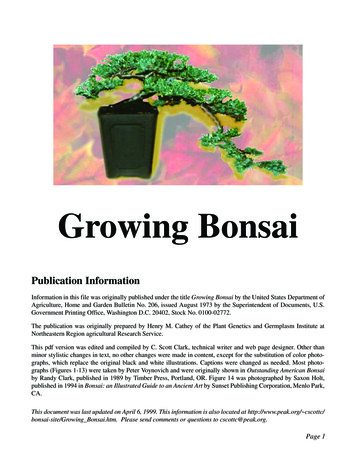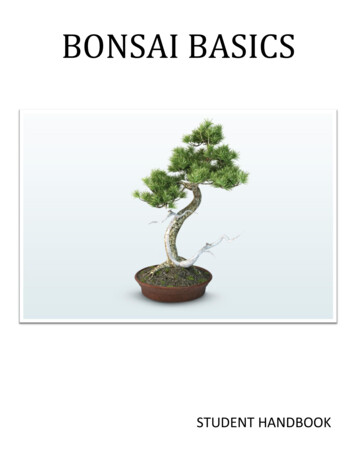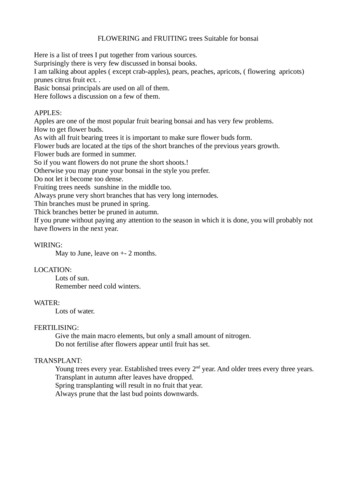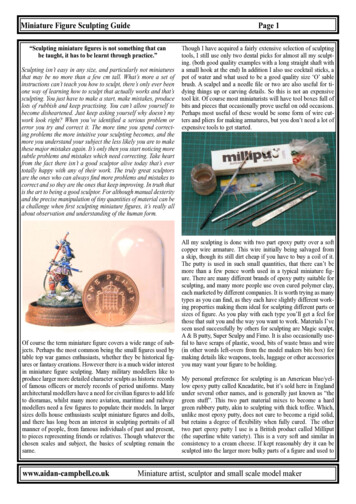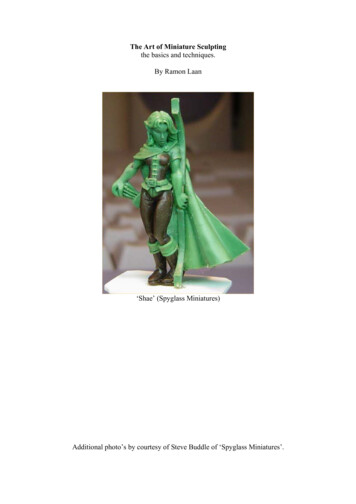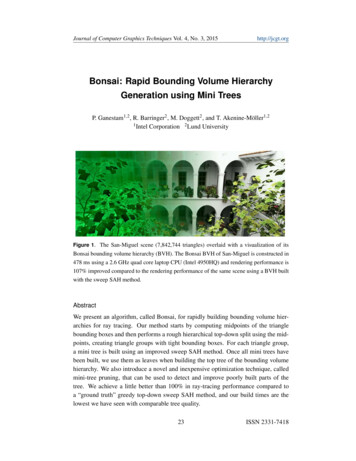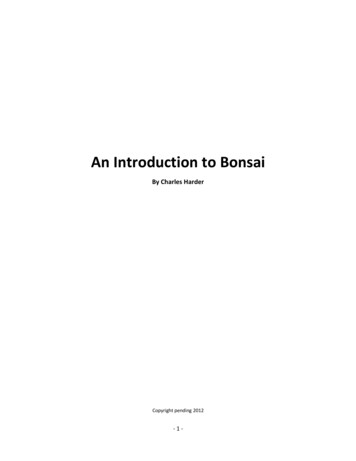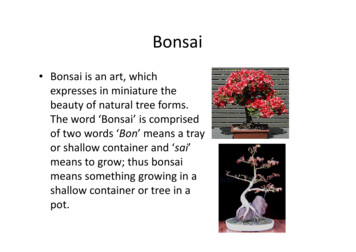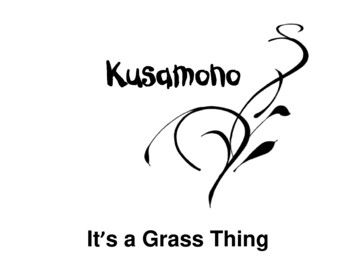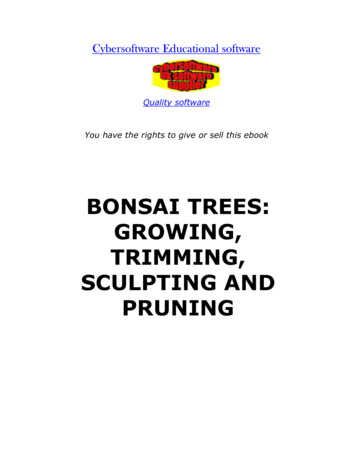
Transcription
Cybersoftware Educational softwareQuality softwareYou have the rights to give or sell this ebookBONSAI TREES:GROWING,TRIMMING,SCULPTING ANDPRUNING
TABLE OF CONTENTSIntroductionBonsai HistoryBonsai StylesFormal UprightInformal UprightSlantingCascadeSemi-CascadeGrowing Indoors or OutdoorsBonsai Tool BoxGrow From Seeds or Buy Trees?Trees Best Suited For BonsaiWhat to Look For In Your TreePlanting the BonsaiPruning and TrimmingWiringWhen to WireWatering and FertilizingRepotting the BonsaiSeasonal CareDisplaying Your BonsaiGeneral 5495052
INTRODUCTION"Bonsai art is the display of a landscape - without thelandscape."--Nobu KajiwaraThis quote couldn’t be truer. Growing and sculptingbonsai trees can be quite a satisfying hobby. It is a hobby;however, that requires a tremendous amount of patience.When you take a simple sapling and mold it to your desire,you’ll be rewarded with a beautiful piece of art you can trulybe proud of!The term bonsai literally means plant in a pot or trayplanting. Bonsai however is much more than simply a plantin a pot. The goal of bonsai is to create the appearance ofgreat size and age. This is accomplished by creating abonsai with strong roots that extend in all directions,creating a sense of stability, a large trunk which tapers as itgoes upward, a clear apex, and well formed and well placedbranches. These features all combine to create a carefulblend of symmetry, balance and proportion. It also must bedisplayed in a pot which harmonizes well with the plantmaterial.Bonsai is the art of growing trees in a confined space tosimulate certain environmental conditions such as great age,extreme weathering, twisted or contorted form, landscape,or other factors. Bonsai trees are modeled on and takeinspiration from nature. The idea of bonsai is to recreatesome of nature's most stunning and beautiful effects ontrees which are reduced in scale.
When undertaking bonsai, you are beginning anexperience that will expand your horizons in countless ways.You may find a new sense of appreciation for nature; youmay start looking at trees, bushes and shrubs differently.You will certainly find yourself looking around all the "worstparts" of your local nurseries where they keep the plantsthat most people wouldn't look twice at. How the art ofbonsai will change you is as unpredictable as nature itself,but be assured of one thing: Bonsai will change the way thatyou look at things.To the Japanese, there is a link to many of the idealsthat their society is based on. Zen Buddhism - where thepastime originated, man, nature, elements and change allare intertwined into this unique method of meditation andexpression. To our world now, bonsai is viewed as a hobbythat allows a greater understanding and being with natureand also a way to enhance our gardens.The tree and the pot involved with bonsai form a singleharmonious unit where the shape, texture and color of one,compliments the other. Then the tree must be shaped. It isnot enough just to plant a tree in a pot and allow nature totake its course - the result would look nothing like a treeand would look very short-lived. Every branch and twig of abonsai is shaped or eliminated until the chosen image isachieved. From then on, the image is maintained andimproved by a constant regime of pruning and trimming.Bonsai is the art of dwarfing trees or plants anddeveloping them into an aesthetically appealing shape bygrowing, pruning and training the trees into containersaccording to prescribed techniques.Overall, bonsai is a great interest, hobby or evenprofession to undertake. Although famous theologians haveclaimed that it is actually 90% art to a meager 10% of
horticulture, it has to be said that a successful bonsai ismost definitely a horticultural masterpiece.Once arriving in the Western world, this enjoyable andrewarding pastime has never turned back, and has gained amagnificently diverse range of plant material andtechniques.Given proper care, bonsai can live for hundreds ofyears, with prized specimens being passed from generationto generation, admired for their age, and revered as areminder of those who have cared for them over thecenturies. Although these bonsai are extremely beautiful meticulously cared for over the years and containing such awealth of knowledge, age is not essential. It is moreimportant that the tree produce the artistic effect desired,that it be in proper proportion to the appropriate container,and that it be in good health.Bonsai is an artistic representation of a natural tree. Itis an image, an illusion of nature. It is smoke and mirrorsthat defies the senses. The best bonsai are magicians' tricksthat have fooled the eye into seeing a far off place in thedistant past, or the side of a craggy cliff. We all have tostrive to be the magician."In this book, we will introduce you to bonsai techniquesand how to grow your own bonsai masterpieces. The beautyof bonsai is that there is no definitive “right way” to do it.We can offer up tips and tricks to craft your own bonsai, buthow. Enter into the world of bonsai and gain a new insightinto life!BONSAI HISTORYThe history of bonsai is long and storied. Bonsai firstappeared in China over a thousand years ago on a verybasic scale, known as pun-sai. Pun-sai was the practice ofgrowing single specimen trees in pots. These early
specimens displayed little foliage and rugged, gnarled trunkswhich often looked like animals, dragons and birds. Thereare a great number of myths and legends surroundingChinese bonsai. The grotesque or animal-like trunks androot formations are still highly prized today.With Japan's adoption of many cultural trademarks ofChina - bonsai was also taken up, introduced to Japanduring the Kamakura period (1185 - 1333) by means of ZenBuddhism - which at this time was rapidly spreading aroundAsia. The exact time is debatable, although it is possible thatit had arrived in AD 1195 as there appears to be a referenceto it in a Japanese scroll attributed to that period.Once bonsai was introduced into Japan, the art wasrefined to an extent not yet approached in China. Over time,the simple trees were not just confined to the Buddhistmonks and their monasteries, but also later were introducedto be representative of the aristocracy - a symbol of prestigeand honor. The ideals and philosophy of bonsai were greatlychanged over the years. For the Japanese, bonsai representsa fusion of strong ancient beliefs with the Easternphilosophies of the harmony between man, the soul andnature.In an ancient Japanese scroll written in Japan aroundthe Kamakura period, it is translated to say: "To appreciateand find pleasure in curiously curved potted trees is to lovedeformity".Whether this was intended as a positive or negativestatement, it leaves us to believe that growing dwarfed andtwisted trees in containers was an accepted practice amongthe upper class of Japan by the Kamakura period. By thefourteenth century bonsai was indeed viewed as a highlyrefined art form, meaning that it must have been anestablished practice many years before that time.
Bonsai were brought indoors for display at special timesby the 'Japanese elite' and became an important part ofJapanese life by being displayed on specially designedshelves. These complex plants were no longer permanentlyreserved for outdoor display, although the practices oftraining and pruning did not develop until later - the smalltrees at this time still being taken from the wild.In the 17th and 18th century, the Japanese artsreached their peak and were regarded very highly. Bonsaiagain evolved to a much higher understanding andrefinement of nature - although the containers used seemedto be slightly deeper than those used today. The main factorin maintaining bonsai was now the removal of all but themost important parts of the plant. The reduction ofeverything just to the essential elements and ultimaterefinement was very symbolic of the Japanese philosophy ofthis time.At around this time, bonsai also became commonplaceto the general Japanese public - which greatly increaseddemand for the small trees collected from the wild andfirmly established the art form within the culture andtraditions of the country.Over time, bonsai began to take on different styles,each which varied immensely from one another. Bonsaiartists gradually looked into introducing other culturallyimportant elements in their bonsai plantings such as rocks,accent plants, and even small buildings and people which isknown as the art of bon-kei. They also looked at reproducingminiature landscapes in nature - known as sai-kei whichfurther investigated the diverse range of artistic possibilitiesfor bonsai.Finally, in the mid-19th century, after more than 230years of global isolation, Japan opened itself up to the restof the world. Word soon spread from travelers who visitedJapan of the miniature trees in ceramic containers which
mimicked aged, mature, tall trees in nature. Furtherexhibitions in London, Vienna and Paris in the latter part ofthe century - especially the Paris World Exhibition in 1900opened the world's eyes up to bonsai.Due to this phenomenal upsurge in the demand forbonsai, the now widely expanding industry and lack ofnaturally-forming, stunted plants led to the commercialproduction of bonsai by artists through training young plantsto grow to look like bonsai. Several basic styles wereadopted, and artists made use of wire, bamboo skewers andgrowing techniques to do this - allowing the art to evolveeven further. The Japanese learned to capitalize on theinterest in this art form very quickly - opening up nurseriesdedicated solely to grow, train and then export bonsai trees.Different plants were now being used to cater forworldwide climates and to produce neater foliage and moresuitable growth habits. Bonsai techniques such as raisingtrees from seed or cuttings and the styling and grafting ofunusual, different or tender material onto hardy root stockwere further developed.Bonsai has now evolved to reflect changing tastes andtimes - with a great variety of countries, cultures andconditions in which it is now practiced.In Japan today, bonsai are highly regarded as a symbolof their culture and ideals. The New Year is not completeunless the tokonoma - the special niche in every Japanesehome used for the display of ornaments and prizedpossessions - is filled with a blossoming apricot or plum tree.Bonsai is no longer reserved for the upper-class, but is a joyshared by executive and factory worker alike.The Japanese tend to focus on using native species fortheir bonsai - namely pines, azaleas and maples (regarded
as the traditional bonsai plants). In other countries however,people are more open to other opinions.The evolution of bonsai over the past two centuries istruly amazing. Perhaps it is symbolic of how small the worldis getting as people from Europe to the United States andeven in Greenland are exploring bonsai as a hobby.And now it’s your turn! First, let’s explore styles ofbonsai.BONSAI STYLESIt is important for you to remember, as a beginner,that no single bonsai style is the “right” style. Bonsai ismeant to be a representation of a tree in nature. Crafting abonsai masterpiece is tantamount to how YOU view thattree. You are not learning from a bonsai master, you aresimply being given instruction on how to create your ownbonsai. What you make of it lies simply in your own mind.You should strive to make your bonsai trees look asnatural as possible. Let the tree suggest its ownpossibilities. If the trunk bends to the right, let it bend thatway. Work with it to make it a main feature of your bonsai.You must listen to the tree and hear what it is telling you.Then you will come up with a beautiful creation!Bonsais should simulate age. You should try andproject the appearance of maturity in your tree – just in aminiature form. Even if your tree is relatively young, youcan groom it so it looks like it has been growing for yearsand years.Two features that give the appearance of age to treesare the caliper of the trunk and the degree of taper of thetrunk. The trunks of bonsai (in most styles) will be very wideat the base and taper very smoothly to the top of the tree
There are two general styles of bonsai: the classic(koten) and the informal or 'comic' (bunjin). In the former,the trunk of the tree is wider at the base and tapers offtowards the top; it is just the opposite in the 'bunjin', a stylemore difficult to master.When you start a bonsai, always remember that youare working with a living plant. Look carefully at its naturalcharacteristics and you may discern within them a suitablestyle, or styles. Often you can train a plant into severalstyles, even if it is basically upright like a beech or elegantlyslender like a maple. Even if one style only really suits aparticular plant, you still can interpret this in many differentways.More than anything else you should not try to train abonsai to grow in a style it is not accustomed to. Study thenatural growth patterns of the tree you are going to growand enhance on the pattern nature gave it.The five basic bonsai styles are formal upright, informalupright, slanting (or windswept), semi-cascade and cascade.All have their own individual beauty and serenity.Formal UprightA tree with a style such as formal upright occurs whenit has grown in the open under perfect conditions. The mostimportant requirement for this style is that the trunk shouldbe perfectly straight, tapering naturally and evenly frombase to apex. The branches should be symmetrically spacedso that they are balanced when viewed from any direction.It is quite a demanding style to achieve.
Junipers, pines, and spruces are great to try and growin the formal upright style.To achieve an effective formal upright style, make surethat about one third of the trunk is visible from the front.This can be from the base to the first branch orcu
bonsai, the now widely expanding industry and lack of naturally-forming, stunted plants led to the commercial production of bonsai by artists through training young plants to grow to look like bonsai. Several basic styles were adopted, and artists made use of wire, bamboo skewers and growing techniques to do this - allowing the art to evolve even further. The Japanese learned to capitalize on .File Size: 222KBPage Count: 56
